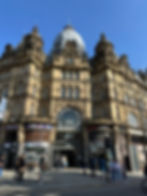Leeds Kirkgate Market and the site's 200 year heritage
- timbarber
- Jun 21, 2025
- 4 min read

I’ve been going to Leeds market since I arrived in Leeds as a student, when weekly trips were made to buy cheap food and bags of broken fish fingers from the Jack Fulton store. Nowadays if I am in Leeds I still like to potter down the aisles, take in the atmosphere, but some West Indian hot chillis and grab something to eat from the street food area at the bottom of the market.

The now Grade 1 listed Leeds Kirkgate Market has an interesting history, there has been an outdoor market on the Kirkgate site since 1826 after the original market in Briggate was no longer big enough to hold all the stall holders for the growing city. The Leeds vicarage and croft were purchased to create a fruit, vegetable and cattle market. (It’s where the road name Vicar Lane originates).

And when the first indoor market opened in 1857 it held the record of the largest indoor market in Europe. Back in the 1800’s, the initial brief was for the location not just to be a market, but a “shopping experience” so the council modelled the building on the celebrated architect Joseph Paxton’s Crystal Palace in London.
In 1857, the Leeds Guide stated ‘The building is of iron and glass, covering an area of 4,040 yards, and is situated at the junction of Vicar Lane and Kirkgate. The style of architecture is Gothic. It has 44 convenient shops on the outside and 35 inside, where there are also four rows of iron stalls. At night this beautiful crystal market hall is well illuminated by 200 gas lights, arranged round handsome cast iron pillars. Altogether it is the most completed structure of its kind in England’
In the 1890’s Leeds has the first innovative cooled area in a market and opened “Fish Row”, still in existence nowadays (in a different area to the original) and one of the most interesting areas of today’s market with its wide variety of fresh fish and shellfish bought in daily from the coast.

One favourite stall is Hayes Seafoods, first established in 1880. There is always a queue as people visit the stall to sample fresh oysters!


40 years after the original indoor market was built, with Leeds having been granted city status in 1893 and the original covered market being in need of repair & starting to leak, the council decided that it needed an even bigger, better market.
In 1897 tenders were requested to create a new market together with a new grand frontage including the entrance which we see today fronting Vicar Lane and George Street. The tender was won by London architects Joseph and John Leeming (they had recently designed the new Halifax Market Hall).
There are records of demonstrations against Leeds City Council when in 1901, traders were given just 7 days-notice of the start of demolition for the re-build.

This new front part of the market is known as the 1904 Hall and has a distinctive, easy to recognise Art Nouveau style on the outside.
The 1904 Hall is the most ornate of the market halls with a glass roof and surrounding balcony. The painted decorated cast iron work around the outside with its green paintwork and red dragons gives this part of the market it’s unique character.



During World War 2, Leeds was bombed and parts of the market hit in 1941, but Yorkshire grit meant that the market which was so important when it came to feeding and clothing the city during the war hardly ever closed.
This resilience was to surface again, when near Christmas in 1975 a fire broke out and burnt down two thirds of the market. The new 1904 Hall survived and this part of the market re-opened 3 days later. The market was re-developed and new halls were opened the following year.

Perhaps the most famous story about former stall holders is the fact that the first Marks and Spencer’s opened as a stall on Leeds City Market as a “penny bazaar”. In 1884, Lithuanian Michael Marks set up a stall, later taking on a partner in Thomas Spencer from Skipton.



The penny bazaar had the snappy advertising slogan of “You don’t need to ask the price, it’s a penny!” In 2012 to belatedly celebrate the centenary, a Marks and Spencer market clock was installed in the centre of the market as well as a stall bearing the shops name. (The original market clock was moved to Oakwood in Leeds).
A shout out must be made to The Nut Shop, a stall near the M&S clock, which in December sells a ready mixed Christmas cake mix with all the dried fruit and ingredients to make your life easier during the festive season.

More recently Leeds Market has established a busy and popular “Market Kitchen” area with stall such as Mr. Mackeral, Istanbul Bakery, Fat Annies and Manjits Kitchen.


Leeds Kirkgate Market is still one of the largest covered markets in Europe, with over 800 stall holders and regularly attracting 100,000 visitors a week. Whilst my visits are less regular these days and the need to procure bags of broken fish fingers from discount stalls no longer on my to do list, I do love to visit the monthly Leeds Record Fairs held at the market on the 2nd Saturday of every month!



